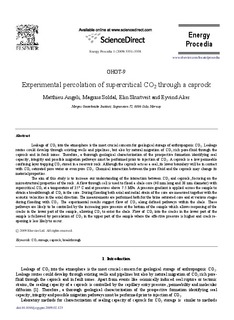| dc.description.abstract | Leakage of CO2 into the atmosphere is the most crucial concern for geological storage of anthropogenic CO2. Leakage routes could develop through existing wells and pipelines, but also by natural migration of CO2 rich pore-fluid through the caprock and in fault zones. Therefore, a thorough geological characterization of the prospective formation identifying seal capacity, integrity and possible migration pathways must be performed prior to injection of CO2. A caprock is a low permeable confining layer trapping CO2 stored in a reservoir rock. Although the caprock acts as a seal, its lower boundary will be in contact with CO2 saturated pore water or even pure CO2. Chemical interaction between the pore fluid and the caprock may change its material properties.
The aim of this study is to increase our understanding of the interaction between CO2 and caprock, focusing on the microstructural properties of the rock. A flow through cell is used to flood a shale core (40 mm long and 38 mm diameter) with supercritical CO2 at a temperature of 35 ∘C and at pressures above 7.5 MPa. A pressure gradient is applied across the sample to obtain a breakthrough of CO2 in the core. During flooding both axial and radial strain of the core are measured together with the acoustic velocities in the axial direction. The measurements are performed both for the brine saturated core and at various stages during flooding with CO2. The experimental results suggest flow of CO2 along defined pathways within the shale. These pathways are likely to be controlled by the increasing pore pressure at the bottom of the sample which allows reopening of the cracks in the lower part of the sample, allowing CO2 to enter the shale. Flow of CO2 into the cracks in the lower part of the sample is followed by percolation of CO2 in the upper part of the sample where the effective pressure is higher and crack reopening is less likely to occur. | |
